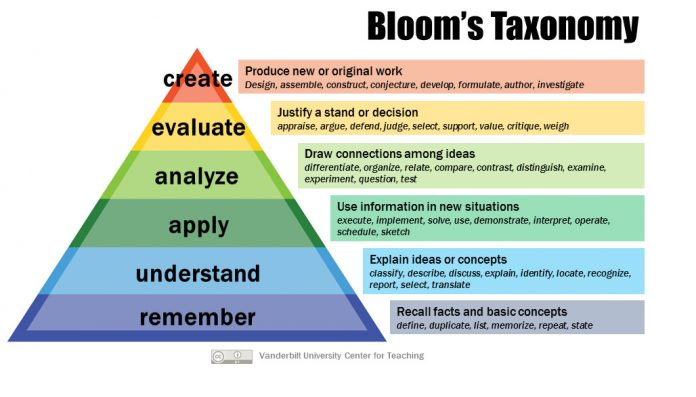6.4 The 3 C’s
Understanding reinforcement can foster a proper learning atmosphere within organizations. The learning cycle, along with the theories of organizational learning all share one connection: behavioral knowledge. The interpretation of behavioral knowledge is outlined by the 3 C’s:
- Cognitivism
- Constructivism
- Connectivism
Cognitivism
The concept of cognitivism was founded upon the belief of identifying the mental process: internal and conscious representations of the world[13]. Cognitivist theory, within the organization, follows many similar ideas to the self-efficacy theory of enacting mastery. One of the most common learning theories within a cognitivist approach is Bloom’s Taxonomy developed in 1956[14]. Bloom’s taxonomy is a lesson in scaffolding that strives for mastery. In recent years, Anderson and Krathwohl have modified the original 1956 version to accommodate today’s understanding of knowledge[15]:

Constructivism
While cognitivism is about identifying the mental process, constructivism is about identifying the experiential process. Constructivism is the belief that all knowledge is subjective in nature, constructed from reality, and mutually agreed upon in a consensus[16]. This pragmatic approach follows the idea that what is seen as a consensus is relatable to truth. performing tasks that will produce quantifiable results show shades of expectancy theory. However, perceptions of truth differ. For example, two friends see a car pass by. One says the care was travelling 60/mph, while the other says the car was going 50/mph. Which statement is true? To quantify if the car was going 50/mph or 60/mph, it needs to be determined whether the car is present. The speed of the car is subjective, and up for debate, but the constructive fact is that the car was present.
The subjective nature is important to understand constructivism, and in-turn find ways to deconstruct subjectivity. One way educators use constructivist theory in organizations is to have adults develop reflections on their experience[16]. The use of thoughtful reflection, either written or verbal, helps to better understand the concepts within a learning environment. Reflections find a connection within Bloom’s Taxonomy model by moving up from understanding and remembering, to applying, analyzing, evaluating, and creating.
Connectivism
A newer form of understanding is through connections. Connectivism, according to Siemans, is knowledge that is created beyond the level of individuals and that knowledge, through a network of connections, is continuously changing[17]. The connected world relates to the idea of globalization as mentioned in Chapter Two. The modern world is interconnected, and whether you are a manager within an organization, or an educator within an institute of high learning, the concepts of connectivism will be needed to enhance the teaching and learning of students or employees.
The belief of identifying the mental process; internal and conscious representations of the world
The belief that all knowledge is subjective in nature, constructed from reality, and mutually agreed upon in a consensus
The belief that knowledge is created beyond the level of individuals, and that knowledge through a network of connections is continuously changing

